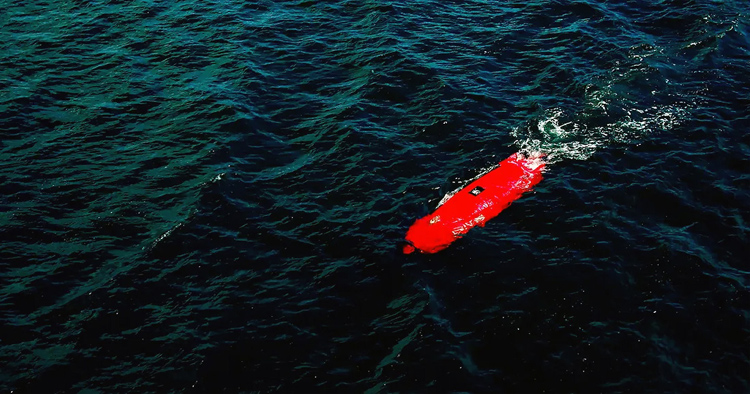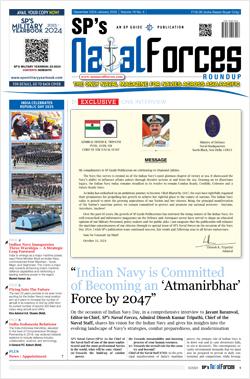INDIAN ARMED FORCES CHIEFS ON OUR RELENTLESS AND FOCUSED PUBLISHING EFFORTS

The insightful articles, inspiring narrations and analytical perspectives presented by the Editorial Team, establish an alluring connect with the reader. My compliments and best wishes to SP Guide Publications.

"Over the past 60 years, the growth of SP Guide Publications has mirrored the rising stature of Indian Navy. Its well-researched and informative magazines on Defence and Aerospace sector have served to shape an educated opinion of our military personnel, policy makers and the public alike. I wish SP's Publication team continued success, fair winds and following seas in all future endeavour!"

Since, its inception in 1964, SP Guide Publications has consistently demonstrated commitment to high-quality journalism in the aerospace and defence sectors, earning a well-deserved reputation as Asia's largest media house in this domain. I wish SP Guide Publications continued success in its pursuit of excellence.
- MoD initiates comprehensive review of Defence Acquisition Procedure 2020, pushes for defence reforms
- G7: The Swansong
- Kalinga Connect: South Asia to Polynesia
- Advanced MRSAM for India for a greater firepower
- Must Credit DRDO for Operation Sindoor, now what is next for defence R&D?
- Operation Sindoor | Day 2 DGMOs Briefing
- Operation Sindoor: Resolute yet Restrained
Breaking Boundaries with Autonomous Systems
A leading transformation in drone technology has broken into Algorithmic warfare-based UAVs, making the latest and most disruptive technology in defence. AI-powered and based on ML, Anduril's innovation is already seen as the new frontier in unmanned systems. Why does such advancement matter to India?

In 2017, as part of a radical initiative the US Department of Defense unveiled the Algorithmic Warfare Cross-Functional Team, known as Project Maven, which was tasked to address the latest AI advancements in military systems. It began with a crucial breakthrough in battlefield technology, starting with a project to improve image recognition for drones operating in the Middle East.
Leading a transformation in military innovation, Palmer Luckey, the entrepreneur behind Oculus VR, went out to redefine what it means to bring Silicon Valley-style disruption to the defence industry.
At the heart of Anduril's technology is Lattice, an AI-powered command and control system that integrates various sensors and autonomous systems. Breaking some of the complex challenges in analysing multiple and massive meshes of data, the Lattice processes massive amounts of battlefield data in real time, giving military operators actionable intelligence. Its open architecture allows seamless integration with third-party systems, making it adaptable for various defence needs. The key breakthrough is the autonomous scale, machine learning (ML) and computer vision (CV) algorithms are used to identify and track targets.
Leading a transformation in military innovation, Palmer Luckey, the entrepreneur behind Oculus VR, went out to redefine what it means to bring Silicon Valley-style disruption to the defence industry.
How does it work for India where the Indian drone manufacturers/integrators/startups while progressing on some level, largely, rely on global partners for critical components such as semi-conductors, motors, actuators, communication systems, data links, data storage, Ground Control Stations (GCS), magnets, software, miniaturised sensors and payloads?
Lattice for Mission Autonomy
The technology here is a hardware-agnostic, end-to-end software platform that allows humans to employ autonomous systems in a way they never have before. What does this end-to-end software platform perform? The lattice enables teams of diverse robotic systems to work to dynamically perform complex missions in any domain. Under military command and supervision, it can extend reach, capabilities, and situational awareness while enabling warfighters to make better decisions, faster.
Powered by Lattice, autonomous Unmanned Aerial Vehicles (UAVs) are developed into advanced air systems for defence breaking into critical innovations and developing additional UAVs for combat applications.
At the heart of Anduril's technology is Lattice, an AI-powered command and control system that integrates various sensors and autonomous systems. Breaking some of the complex challenges in analysing multiple and massive meshes of data, the Lattice processes massive amounts of battlefield data in real time, giving military operators actionable intelligence.
Additionally, In the area of Autonomous Underwater Vehicles (AUVs), these cutting-edge systems are being prototyped as part of a Defence Innovation Unit project aimed at large-scale unmanned undersea vehicles.
The open system offers a powerful solution to modern warfare's growing threat of drone attacks, pioneering AI-based hardware in defence technology. In a demonstration and some of the unclassified reports mentioned Anduril's counter-UAS system managed to detect, track, and neutralise several drones on the battlefield of an ongoing global conflict.
Its underwater autonomous vehicle (AUS) called DIVE-LD showcased a variety of military and commercial missions in long-range oceanographic sensing, undersea battlespace awareness, mine countermeasures and anti-submarine warfare. It achieved the depth based on the combination of Additive Manufacturing (LFAM) techniques in Anduril's autonomy software, Lattice OS.
One of the successful attempts, Anvil which is designed as an inceptor, locates target drones using computer vision and can be commanded to ram targets by its operator. While the drone has already achieved speeds of up to 320 km/h it is now coming up in versions to attack larger targets such as helicopters or cruise missiles.
The most challenging part remains in developing a sensor fusion platform to integrate multiple sensor technologies into a flexible, open API architecture, streamlining integration processes and accelerating the adoption of advanced technologies across complex security programmes.
The most challenging part remains in developing a sensor fusion platform to integrate multiple sensor technologies into a flexible, open API architecture, streamlining integration processes and accelerating the adoption of advanced technologies across complex security programmes. The advancement in this area is not unique in the world of military technology but only such project which is being conducted.
In fact, the much talked about UAV-- "Ghost" -- can perform multiple roles due to its five modular payload bays, such as utilising laser weapons or detecting and tracking cruise missiles. It is now being used by the United States Department of Defense and The Royal Navy of the UK among others.
The advancement is based on on-board processing chips, due to bandwidth limitations for communication links, and to enable radio silence, by processing imagery independently without the need for a centralised analysis system that requires communication.
Collaboration with India
To focus on developing modular Autonomous Underwater Vehicles (AUVs) that can be rapidly deployed for Security, Surveillance, Survey, and Reconnaissance missions, a collaboration has taken place in India. This is significant as the collaboration aims to address the niche and critical technology for the Indian armed forces, enhancing underwater operational capabilities.
Mahindra Group and Anduril Industries have announced a strategic partnership aimed at co-developing and co-producing state-of-the-art Autonomous Maritime Systems, advanced AI-enabled Counter Unmanned Aerial System (CUAS) technologies and innovative Command and Control (C2) software.
Certainly, it is a step for the emerging technologies and how all leading Indian defence manufacturers like Mahindra can leverage such advancement will be a great leap in building an unmanned ecosystem in India which is still under the basic to progressive scale in its solutions to military.
According to the senior official, the collaboration seeks to strengthen regional security by deploying next-generation autonomous solutions and enhancing capabilities for maritime operations.
It also aims to develop advanced Counter-Unmanned Aerial Systems (CUAS) technologies capable of detecting and neutralising drone threats, providing enhanced protection against unmanned aerial systems.
Certainly, it is a step for the emerging technologies and how all leading Indian defence manufacturers like Mahindra can leverage such advancement will be a great leap in building an unmanned ecosystem in India which is still under the basic to progressive scale in its solutions to military.
Mahindra does recognise the opportunity and challenges in its quest for hi-calibre unmanned space, especially in the underwater domain. "Partnering with Anduril Industries marks a significant milestone in Mahindra Group's commitment to developing advanced security and autonomous technologies. This collaboration combines our deep engineering expertise with Anduril's innovative solutions to deliver cutting-edge capabilities that enhance security and address emerging threats, says Vinod Sahay, President, Aerospace & Defense, Mahindra Group.
Global security forces face a rapidly evolving set of threats from both emerging unmanned systems and legacy manned platforms, and Autonomy is key to maintaining credible protection. Greg Kausner, SVP- Global Defence, Anduril Industries looks at Indian collaboration to develop such advanced underwater unmanned systems which could be specific to the maritime in the IOR and beyond.
Manish Kumar Jha is a Consulting & Contributing Editor for SP's Aviation, SP's Land Forces and SP's Naval Forces and a security expert. He writes on national security, military technology, strategic affairs & policies.





